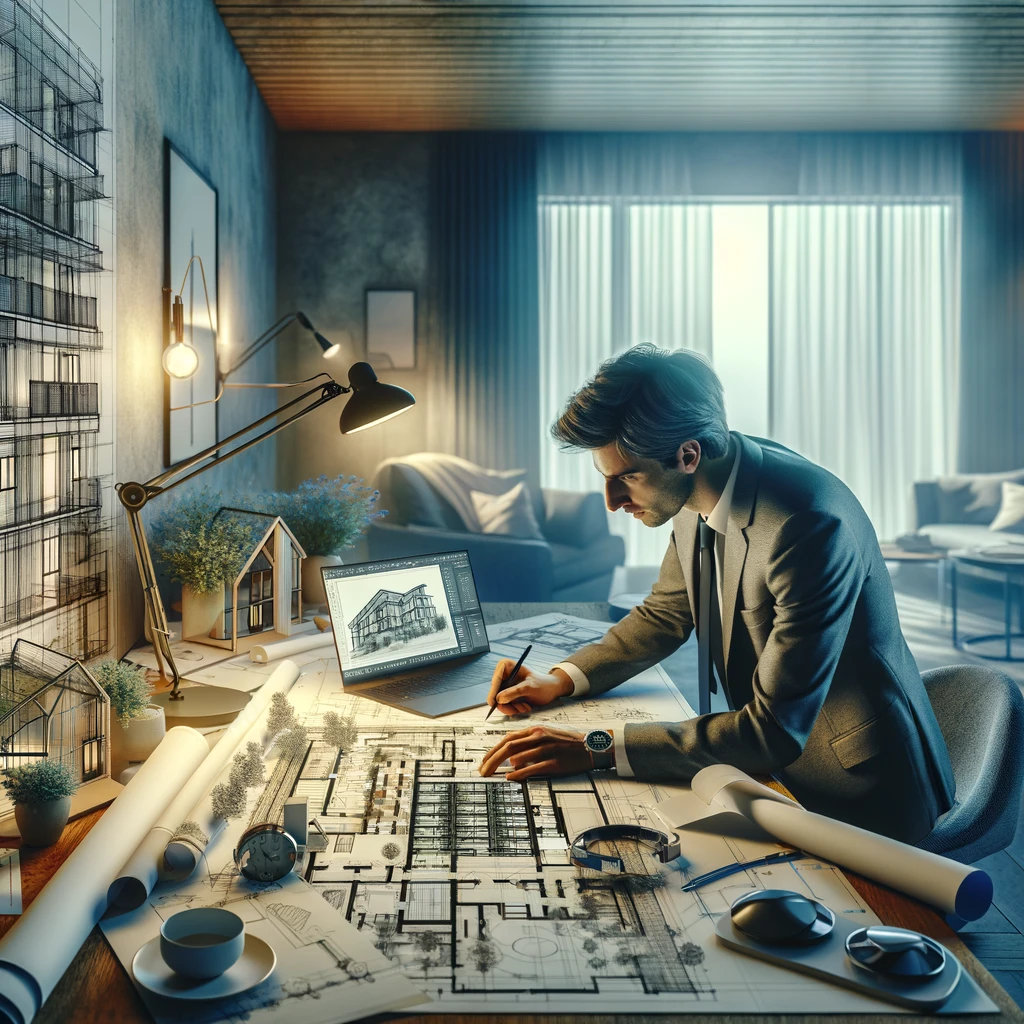Elevating Hotel Experiences Through Freelance Architecture & Building Design: A Case Study on SereneStay

Introduction
In an era where the hospitality industry faces unprecedented competition and ever-evolving guest expectations, the physical design and architectural appeal of hotel properties have emerged as pivotal factors in attracting and retaining clientele. Recognizing the critical role of design in shaping guest experiences and the overall brand image, SereneStay, an emerging leader in the hotel sector, identified the necessity for a strategic overhaul of their properties. With a vision to not only meet but exceed the modern traveler's desire for aesthetic appeal, comfort, and sustainability, SereneStay embarked on an ambitious initiative to reimagine and revitalize their hotels.
Understanding that innovation and adaptability are key to staying ahead in a competitive landscape, SereneStay sought to leverage the expertise and fresh perspectives of freelance professionals in Architecture & Building Design. This approach was driven by the need to introduce cutting-edge, sustainable design solutions that could transform their properties into spaces that resonate with contemporary tastes and environmental consciousness. By embracing the versatility and creativity offered by freelance architects and designers, SereneStay aimed to create unique, memorable experiences for their guests, thereby reinforcing their brand's commitment to excellence and innovation in hospitality.
The Challenge
SereneStay faced a multifaceted challenge that extended beyond mere aesthetic updates. The hotel chain's leadership recognized that to truly stand out in the saturated hospitality market, they needed to address several critical areas.
1. Modernizing Aesthetic Appeal: The existing designs of SereneStay's properties reflected trends and preferences from a bygone era, which no longer aligned with the expectations of today's travelers. The challenge was to reimagine these spaces in a way that would not only attract guests but also create a lasting impression, encouraging repeat visits and positive word-of-mouth.
2. Enhancing Guest Experience through Functional Design: It became increasingly clear that optimizing the functionality of spaces within the hotels was paramount. This involved rethinking room layouts to maximize space utility and comfort, redesigning common areas to foster social interaction and relaxation, and ensuring that every aspect of the hotel's design contributed positively to the guest experience.
3. Incorporating Sustainable Practices: With growing awareness and concern over environmental issues, SereneStay recognized the need to integrate sustainable design practices into their renovations. This meant adopting energy-efficient systems, using sustainable materials, and designing with the environment in mind, all while maintaining the luxury and comfort that guests expect.
4. Balancing Quality with Cost-Effectiveness: Perhaps one of the most daunting challenges was finding a way to achieve high-quality design transformations that would meet all the above objectives without incurring prohibitive costs. This required innovative thinking and strategic planning to ensure that investments in design and architecture would yield a significant return in terms of enhanced guest satisfaction and increased revenue.
5. Implementing Changes with Minimal Disruption: Finally, SereneStay was acutely aware of the need to minimize operational disruptions during the renovation process. The challenge was to carry out the necessary upgrades and changes in a manner that would not adversely affect the guest experience or the chain's reputation during the transition period.
Addressing these challenges required a comprehensive approach, combining strategic vision with creative and practical solutions. SereneStay's commitment to tackling these issues head-on set the stage for a transformative collaboration with freelance Architecture & Building Design professionals, aimed at redefining the future of hospitality through design.
The Solution
To address the complex challenges it faced, SereneStay embarked on a strategic and innovative path by partnering with a curated team of freelance architects and building designers who specialized in the hospitality sector. This solution was multifaceted, reflecting the diverse nature of the challenges at hand.
1. Curating a Team of Specialized Freelancers: Recognizing the unique requirements of the hospitality industry, SereneStay sought out freelance professionals with specific expertise in hotel design. This included architects who had a proven track record of creating inviting and functional spaces, as well as designers who were at the forefront of sustainable and innovative design practices. By assembling a team with a diverse set of skills and experiences, SereneStay ensured that they had access to a wide range of creative ideas and solutions.
2. Comprehensive Property Assessments: The first step taken by the freelance team was to conduct detailed assessments of each of SereneStay’s properties. These evaluations were not limited to just the physical structures but also included an analysis of guest flow, space utilization, and environmental impact. This holistic approach allowed the team to identify specific areas where improvements could make the most significant impact on guest experience and operational efficiency.
3. Customized Design Solutions: Based on the assessments, the freelancers developed customized design solutions for each property. These solutions ranged from minor tweaks to major overhauls but were always aligned with SereneStay’s objectives of modernizing aesthetics, enhancing functionality, and incorporating sustainable practices. For example, lobby areas were redesigned to be more welcoming and conducive to social interaction, while guest rooms were reconfigured to maximize space and comfort. Energy-efficient lighting and HVAC systems were introduced to reduce the hotels’ carbon footprint.
4. Emphasizing Sustainability and Innovation: A key component of the solution was the emphasis on sustainability and innovation. The freelance team integrated green building practices such as the use of renewable materials, energy-efficient systems, and water-saving fixtures. These measures not only aligned with global environmental standards but also appealed to the growing segment of eco-conscious travelers.
5. Managing Implementation with Minimal Disruption: SereneStay and the freelance team worked closely to ensure that the implementation of design changes caused minimal disruption to hotel operations and guest experiences. This was achieved through careful planning, phased renovations, and clear communication with hotel staff and guests. The aim was to ensure that the transformation process itself would reflect the brand’s commitment to guest satisfaction.
By adopting this comprehensive and flexible approach, SereneStay was able to leverage the expertise and creativity of freelance professionals to transform their properties. This strategic partnership allowed the hotel chain to achieve its objectives of updating its properties to meet and exceed contemporary standards of design, functionality, and sustainability, setting a new benchmark for excellence in the hospitality industry.
The Impact
The strategic decision by SereneStay to employ freelance Architecture & Building Design services had a profound and multifaceted impact on its operations, guest satisfaction, and overall brand reputation.
1. Enhanced Guest Satisfaction and Experience: The redesign and renovation efforts led to a noticeable improvement in guest satisfaction. Travelers were quick to praise the refreshed aesthetics, the thoughtful use of space, and the incorporation of sustainable practices. The modernized, user-friendly environments significantly enhanced the overall guest experience, leading to increased loyalty and positive reviews across various platforms. The attention to detail and the focus on creating inviting and functional spaces directly contributed to a more enjoyable and memorable stay for guests.
2. Increased Occupancy and Revenue: The improvements in design and functionality translated into increased occupancy rates. Guests were more inclined to choose SereneStay over competitors, drawn by the chain's reputation for offering modern, sustainable, and guest-centric accommodations. This uptick in occupancy, coupled with the ability to command higher room rates justified by the enhanced experience, led to a substantial increase in revenue. The financial success underscored the value of investing in architecture and design as strategic business tools.
3. Strengthened Brand Identity: The transformation of SereneStay's properties also played a crucial role in redefining and strengthening the hotel chain's brand identity. The emphasis on innovative, sustainable design positioned SereneStay as a forward-thinking, responsible brand in the hospitality industry. This alignment with contemporary values and expectations attracted not only a broader demographic of guests but also set the chain apart as a leader in environmental sustainability and design excellence.
4. Positive Environmental Impact: By integrating sustainable practices and green building standards into their redesign, SereneStay significantly reduced its environmental footprint. Energy-efficient systems, the use of renewable materials, and water-saving fixtures contributed to lower utility costs and a reduction in waste. This commitment to sustainability resonated with eco-conscious travelers and exemplified the chain's dedication to responsible tourism, further enhancing its reputation and appeal.
5. Catalyzed Industry-Wide Inspiration: The success of SereneStay's initiative served as an inspiration to other entities within the hospitality industry. The chain's ability to seamlessly blend aesthetics, functionality, and sustainability through the expertise of freelance professionals demonstrated that innovative design can be a key differentiator in the competitive landscape. This case study became a benchmark for how hotels can leverage architectural and design services to enhance guest experiences, drive revenue, and promote sustainability.
In conclusion, the impact of partnering with freelance Architecture & Building Design professionals was transformative for SereneStay. The project not only achieved its immediate objectives of improving guest experiences and operational efficiency but also set new industry standards for design, sustainability, and brand excellence.
Conclusion
The journey of SereneStay, from identifying the need for transformative change to successfully implementing strategic design and architectural innovations, underscores a pivotal lesson for the hospitality industry. This case study illustrates that embracing creativity, sustainability, and guest-centric design can lead to substantial improvements in guest satisfaction, operational efficiency, and environmental responsibility. The decision to partner with freelance Architecture & Building Design professionals enabled SereneStay to leverage a wealth of creativity and expertise, resulting in spaces that not only meet but exceed the expectations of modern travelers.
The success of SereneStay's initiative highlights the immense value of investing in design and architecture. It proves that thoughtful, innovative solutions can transform the guest experience, elevate brand identity, and drive business growth. Furthermore, the project showcases the power of collaboration between companies and freelance professionals, illustrating how such partnerships can bring about industry-leading outcomes.
The positive repercussions of SereneStay's redesign extend beyond financial metrics and occupancy rates. By prioritizing sustainability and innovative design, SereneStay has set a new standard for the hospitality industry, demonstrating that hotels can play a significant role in promoting environmental stewardship while enhancing guest experiences. This approach not only appeals to a broad demographic of travelers but also aligns with global efforts towards sustainability, making SereneStay a model for future developments in the sector.
In conclusion, SereneStay's transformation through freelance Architecture & Building Design services is a testament to the potential of strategic design to redefine the hospitality experience. It serves as a compelling case study for hotel chains and businesses across industries, emphasizing the importance of innovation, sustainability, and customer-centricity in achieving lasting success. As the hospitality industry continues to evolve, the lessons learned from SereneStay's experience will undoubtedly influence future design and operational strategies, making a significant impact on the way hotels are conceived and experienced by guests around the world.
Recent Posts
-
04/26/2024Thriving Through Flexibility: How FlexiConsulting Found Success with ZapMyWork
-
04/19/2024Flourishing Home Trends: How "ZapMyWork" Became the Cornerstone of Our Interior Design Success
-
04/15/2024Weaving Success with ZapMyWork's Freelance Marketplace
-
04/12/2024Streamlining Project Management in Small Businesses: The ZapMyWork Experience with ClearVision Consulting
-
04/10/2024Transforming Toy Design with Electronics Engineering Freelancers: A Case Study on ToyInnovate
Store Address
Information
Copyright © 2022 - Present. ZapMyWork, LLC. All Rights Reserved





